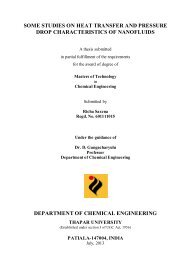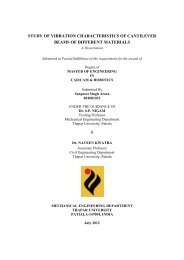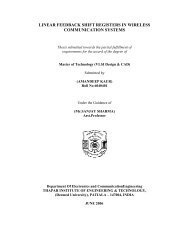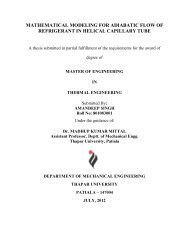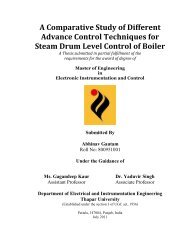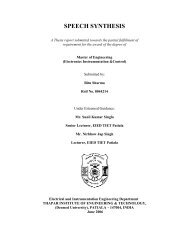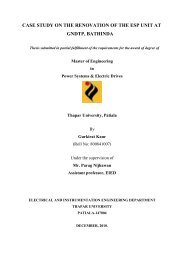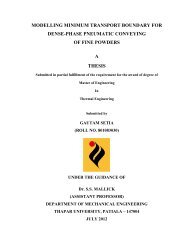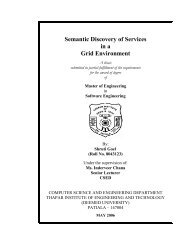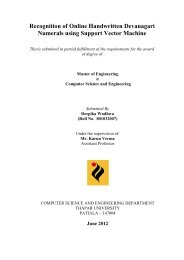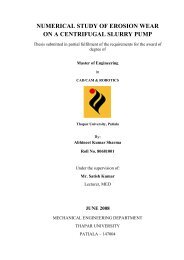from indigenous fermented foods and human gut ... - Thapar University
from indigenous fermented foods and human gut ... - Thapar University
from indigenous fermented foods and human gut ... - Thapar University
Create successful ePaper yourself
Turn your PDF publications into a flip-book with our unique Google optimized e-Paper software.
132<br />
Chapter V Discussion<br />
hypothesized, that one of the mechanisms through which lactic acid bacteria protect the host<br />
<strong>from</strong> infections is by their ability to co-aggregate with intestinal pathogens <strong>and</strong> uropathogenic<br />
bacteria (Reid et al., 1988; Huis in't Veld et al., 1994).<br />
A strong inclination to auto-aggregation does not imply a strong co-aggregation<br />
property, but it has been observed that strains with high co-aggregation ability also show high<br />
auto-aggregation (Ehrmann et al., 2002) <strong>and</strong> our findings also support the same. However,<br />
exceptions were noted as L. casei LAM-1, which had high auto-aggregation values, did not<br />
co-aggregated with S. aureus but weakly with L. monocytogenes. Previous co-aggregation<br />
studies have been limited to bacteria <strong>from</strong> <strong>human</strong> origin. Schachtsiek et al. (2004) first<br />
reported co-aggregation of Lactobacillus coryniformis, a food or feed-associated bacterium,<br />
with pathogens. L. coryniformis was able to coaggregate with E. coli K88, Campylobacter<br />
jejuni <strong>and</strong> Campylobacter coli, but not with S. typhimurium, Clostridium perfringens <strong>and</strong> L.<br />
monocytogenes. In this study, the L casei strains <strong>from</strong> food origin was able to co-aggregate<br />
with <strong>human</strong> pathogens (L. monocytogenes, S. aureus, enterotoxigenic E. coli <strong>and</strong> S.<br />
typhimurium) the co-aggregation derived was higher degree than the commercially used<br />
probiotic strains. Strains (especially the L. casei strains because of their inherent fermentative<br />
versatility) with this property could be of special interest, because co-aggregates may be<br />
formed in the food matrix, <strong>and</strong> thereby prevents the entrapped pathogens <strong>from</strong> adhering to<br />
host cells upon ingestion (Schachtsiek et al., 2004). Decreased numbers of S. aureus together<br />
with increased numbers in Lactobacilli <strong>and</strong> Bifidobacteria in the intestinal microbiota of<br />
infants have been associated with atopic dermatitis (Bjorksten et al., 2001; Watanabe et al.,<br />
2003).<br />
For these reasons, consumption of products enriched with prebiotics <strong>and</strong> probiotic<br />
bacteria (as the strains presented in this study), may compensate the intestinal microbial



